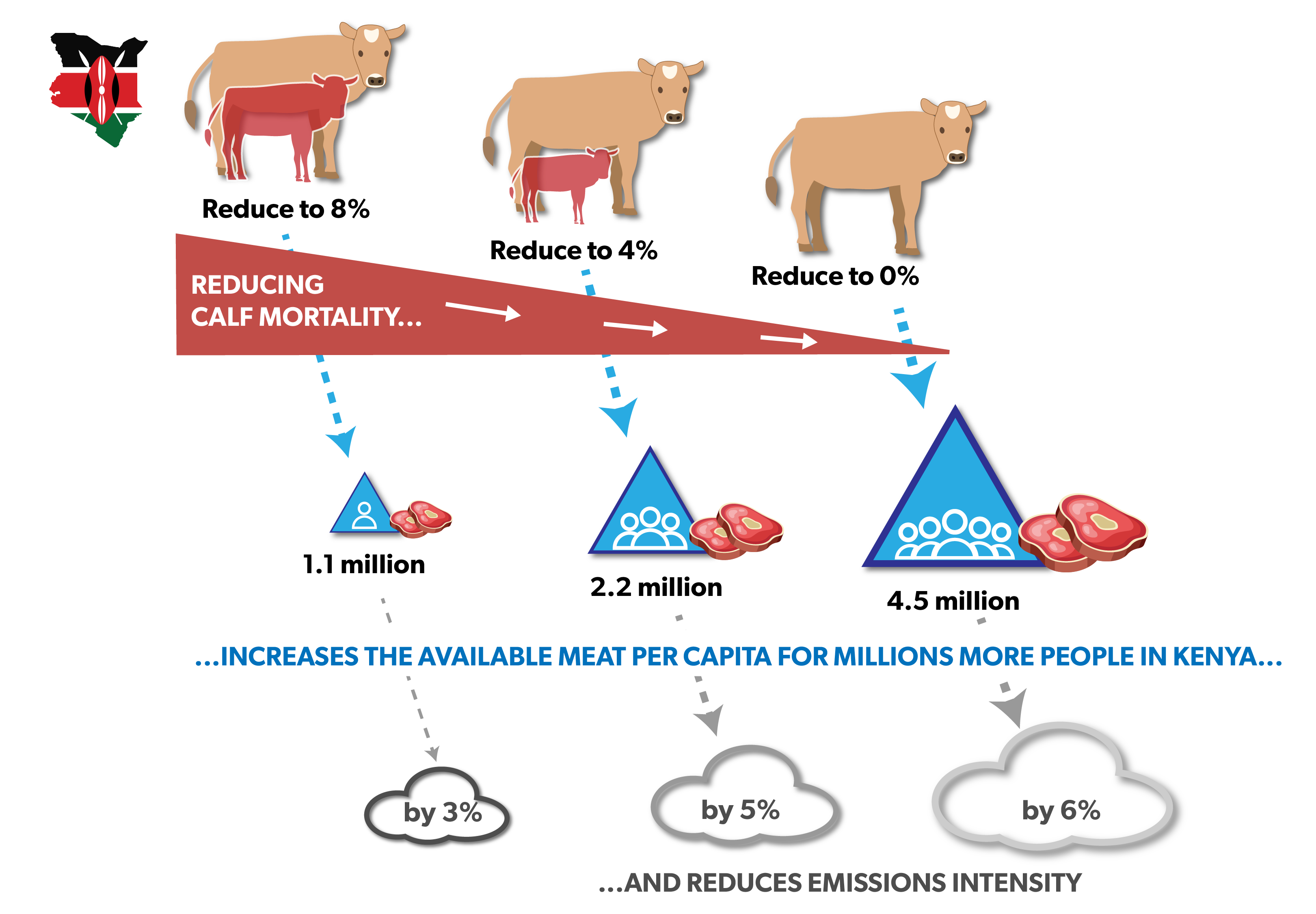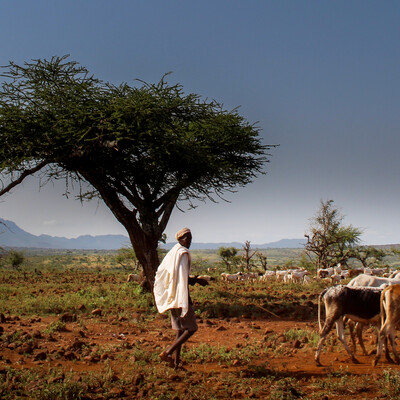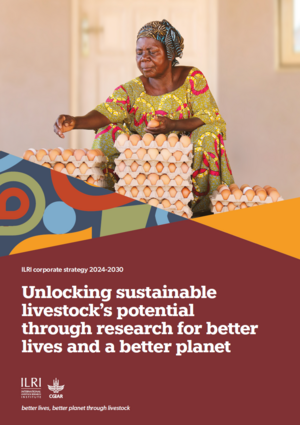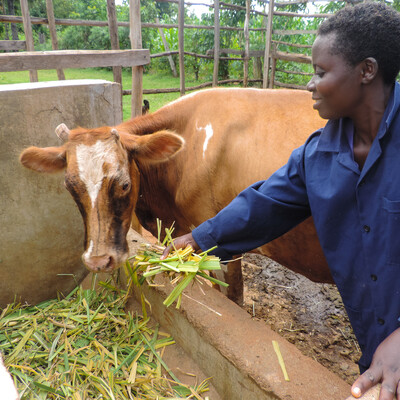

Reducing livestock abortions and calf mortality to improve food security and lower GHG emissions in Tanzania and Kenya
The global livestock sector emits 12% of all GHG emissions associated with human activities, with cattle meat and milk alone contributing 62% of these emissions. Meat demand will triple and milk demand double in Africa by 2050 due to population growth, increased incomes and urbanization. When this happens, higher livestock production will directly increase emissions of enteric methane, a potent greenhouse gas (GHG). However, this can be mitigated through measures that make the livestock sector more efficient by lowering mortality during pregnancy and mortality of calves.
Currently, approximately 20% of global livestock production is lost annually through disease, of which a significant amount is through abortions and calf mortality.
An East African study by ILRI’s Mazingira Centre and Centre For Tropical Livestock Genetics and Health (CTLGH) researchers, together with international partners, finds that livestock abortions (stillbirths) and calf mortality in Tanzania and Kenya cause a loss of animal protein equivalent to the per capita consumption of approximately 5.2 million people.
The study shows that preventing abortions in cattle could lower milk GHG emission intensity (EI)—the amount of GHG produced per unit of meat—by 4.6%, while in goats, the reduction could reach as high as 15.8%. Halving calf mortality would reduce EI by 3%, and eliminating calf mortality would therefore reduce by 6%.
Africa's food security and GHG emissions context
The EI of the sub-Saharan Africa (SSA) livestock sector is high because animals yield relatively low quantities of milk and meat compared to other regions. However, it should be noted that livestock in Africa serve multiple purposes including providing draught power, cultural value, and financial security. These multiple functions are not captured when emissions are expressed per kilogram of milk or meat, leading to an overestimation of emissions intensity when compared to systems that focus solely on production.
Little research has been done in SSA to provide reliable quantitative estimates of livestock sector-related emissions even though livestock farming is a major contributor to agricultural GHG emissions in SSA, accounting for 32% of all man-made GHG emissions in the region.
This research was conducted to address this gap.
How much milk and meat is lost?
Researchers examined two distinct livestock systems: dairy systems in Tanzania and beef systems in Kenya. They used data from previously published studies to assess livestock abortion in indigenous and exotic breeds of cattle and goats in northern Tanzania, and calf mortality in local cattle breeds in western Kenya.
Tanzania: Livestock abortions
The data on livestock abortions was collected in northern Tanzania between October 2017 and September 2019 under a project called Supporting Evidence-Based Interventions in Tanzania (SEBI-TZ).
This region is known for its diverse range of agroecological systems and livestock management practices, including pastoralists, agro-pastoralists, and smallholder farmers. The studies collected data from 13 wards randomly selected from the Arusha, Kilimanjaro and Manyara regions.
Researchers calculated emissions between two groups: animals experiencing abortions and animals not experiencing abortions. They calculated the difference in average daily milk yield between animals that aborted and those that had a live birth.
The researchers followed guidelines provided by the Intergovernmental Panel on Climate Change (IPCC, 2019) for low-productivity systems in Africa, which also provided default values for situations where national data was not accessible.
Kenya: Calf mortality
The data on calf mortality was collected in western Kenya between 2007 and 2009 as part of the Infectious Diseases of East Africa Livestock (IDEAL) project. The study area covered Busia, Bugoma, Kakamega and Siaya counties. It considered 20 sub-locations within each district representing the smallest administrative units in Kenya with available cattle data.
Researchers focused on indigenous African Shorthorn Zebu calves to determine the cause of mortality in a sample of 500 calves. The major cause of calf death was infectious disease, with an overall mortality rate of 16%.
Impact of abortion
When scaled up to national level, around 113,906 abortions occur per year for cattle and 564,497 for goats.
The total milk loss associated with abortion, considering all animal categories, is 35,038 metric tons per year. The total estimated carcass loss associated with abortion, considering all animal categories, is 6,373 metric tons. This represents a significant loss in food protein.

If abortions were reduced the EI of milk would be mitigated by 5% for cattle and 16% for goats.
Impact of calf mortality
Reducing calf mortality has a significant impact on food security.
Assuming a beef consumption rate of 2.64 kg per capita per year, reducing calf mortality could provide meat for millions more people in Kenya.

At 16% calf mortality rate, the EI is 28.0 kg CO₂ e/kg carcass. Reducing the calf mortality rates to 8%, 4% and 0 % could reduce EI by 3%, 5%, and 6%, respectively.
Recommendations
The researchers note that addressing abortions and calf mortality presents opportunities to reduce GHG EI and increase food security through improving overall herd health and management practices.
The researchers also say a more detailed analysis and a more detailed roadmap for potential interventions are needed, including cost-benefit analyses of specific strategies tailored to regional contexts and animal breeds.
Potential strategies include vaccination programs against infectious diseases, biosecurity measures, reproductive management, and calving assistance, among others.
Funding
This work was supported by Programme for Climate-Smart Livestock Systems (PCSL) financed by the GIZ-commissioned German Federal Ministry for Economic Cooperation and Development (BMZ) (grant: 2017.0119.2); CGIAR research initiatives Mitigate+: Research for Low Emissions Food Systems and Livestock and Climate supported by contributors to the CGIAR Trust Fund; the New Zealand Government to support the objectives of the Global Research Alliance on Agricultural Greenhouse Gases; and LM supported by the European Union’s Horizon Europe Programme (grant agreement number 101058525) for the project "Knowledge and climate services from an African observation and Data research Infrastructure (KADI).
Acknowledgments
The authors would like to thank all funders who support this research through their contributions to the CGIAR Trust Fund: www.cgiar.org/funders. The findings and conclusions presented in this work are solely those of the authors and do not necessarily reflect the positions or policies of the funders mentioned above, including the Bill & Melinda Gates Foundation and the UK Government.
Further reading
Tanzania
Semango G, Yoder J, Kibona T, et al. Economic Burden of Livestock Abortions in Northern Tanzania. Journal of Agricultural and Applied Economics. 2024;56(2):195-215. doi:10.1017/aae.2024.6
Lankester, F., Kibona, T., Allan, K. J., de Glanville, W. A., Buza, J. J., Katzer, F., Halliday, J. E. B., Mmbaga, B. T., Wheelhouse, N., Innes, E. A., Thomas, K. M., Nyasebwa, O. M., Swai, E. S., Claxton, J. R., & Cleaveland, S. (2024). The value of livestock abortion surveillance in Tanzania: Identifying disease priorities and informing interventions. eLife, 13, RP95296.
Thomas, K.M., Kibona, T., Claxton, J.R. et al. Prospective cohort study reveals unexpected aetiologies of livestock abortion in northern Tanzania. Sci Rep 12, 11669 (2022). https://doi.org/10.1038/s41598-022-15517-8
Kenya
de Clare Bronsvoort, B.M., Thumbi, S.M., Poole, E.J. et al. Design and descriptive epidemiology of the Infectious Diseases of East African Livestock (IDEAL) project, a longitudinal calf cohort study in western Kenya. BMC Vet Res 9, 171 (2013). https://doi.org/10.1186/1746-6148-9-171
Papers using IDEAL data
You may also like

Opinion and analysis
Sustainable manure management in Uganda requires an enabling policy and legal framework: a call to action!

ILRI News
ILRI introduces the Livestock and Climate Solutions Hub at SAADC 2025 to address climate challenges in livestock systems

ILRI News
When policy meets pasture: Farmers and scientists joining forces to shape a fair climate future
Related Publications

Systematic review on the impacts of community-based sheep breeding programs on animal productivity, food security, women’s empowerment, and identification of interventions for climate-smart systems under the extensive production system in Ethiopia
- Tesfa, Assemu
- Taye, Mengistie
- Haile, Aynalem
- Nigussie, Zerihun
- Najjar, Dina
- Mekuriaw, Shigdaf
- Dijk, Suzanne V
- Wassie, Shimels E
- Wilkes, Andreas
- Solomon, Dawit

Genetic relationships among resilience, fertility and milk production traits in crossbred dairy cows performing in sub-Saharan Africa
- Oloo, Richard Dooso
- Mrode, Raphael A.
- Ekine-Dzivenu, Chinyere C.
- Ojango, Julie M.K.
- Bennewitz, J.
- Gebreyohanes, Gebregziabher
- Okeyo Mwai, Ally
- Chagunda, M.G.G.

The impact of heat stress on growth and resilience phenotypes of sheep raised in a semi-arid environment of sub-Saharan Africa
- Oyieng, Edwin P.
- Ojango, Julie M.K.
- Gauly, M.
- Ekine-Dzivenu, Chinyere C.
- Mrode, Raphael A.
- Clark, E.L.
- Dooso, Richard
- König, S.

Ambient environmental conditions and active outdoor play in the context of climate change: A systematic review and meta-synthesis
- Lee, E.-Y.
- Park, S.
- Kim, Y.-B.
- Liu, H.
- Mistry, P.
- Nguyen, K.
- Oh, Y.
- James, M.E.
- Lam, Steven
- Lannoy, L. de
- Larouche, R.
- Manyanga, T.
- Morrison, S.A.
- Prince, S.A.
- Ross-White, A.
- Vanderloo, L.M.
- Wachira, L.-J.
- Tremblay, M.S.












